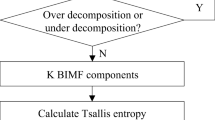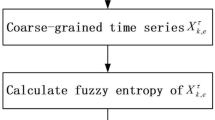Abstract
To make accurate judgments of bearing main fault types using relatively small amounts of fault data, a fault diagnostic method was proposed in this paper. This method combined fuzzy C-means method (FCM) and optimized K-nearest neighbor model to achieve the aim. Firstly, the local mean decomposition and its Shannon entropy are used to analyze the collected bearing vibration signals, so the characteristic values fault features are extracted. Then, FCM was used to pre-classify fault training samples, so as to classify the typical features basically. Then, the K-nearest neighbor model optimized by the particle swarm optimization model was established and used to achieve the bearing fault diagnosis finally. Experimental results have proven that the proposed method achieves perfect results in diagnosing bearing’ faults.







Similar content being viewed by others
References
Jaouher BA, Nader F, Lotfi S (2015) Application of empirical mode decomposition and artificial neural network for automatic bearing fault diagnosis based on vibration signals. Appl Acoust 89:16–27
Dong SJ, Tang BP, Chen RX (2015) Bearing running state recognition based on non-extensive entropy scale wavelet feature and support vector machine. Measurement 46(10):4189–4199
Qin Y, Tang BP, Wang JX (2010) Higher-density dyadic wavelet trans- form and its application. Mech Syst Signal Process 24:823–834
Du SC, Huang DL (2013) Recognition of concurrent control chart patterns using wavelet transform decomposition and multiclass support vector machines. Comput Ind Eng 66:683–695
Konar P, Chattopadhyay P (2011) Bearing fault detection of induction motor using wavelet and Support Vector Machines (SVMs). Appl Soft Comput 11:4203–4211
Golafshan R, YuceSanliturk K (2015) SVD and Hankel matrix based de-noising approach for ball bearing fault detection and its assessment using artificial faults. Mech Syst Signal Process. doi:10.1016/j.ymssp.2015.08.012i
Tang BP, Dong SJ (2012) Method for eliminating mode mixing of empirical mode decomposition based on the revised blind source separation. Signal Process 92:248–258
Cheng JS, Yi Y, Yu Y (2012) A rotating machinery fault diagnosis method based on local mean decomposition. Digit Signal Proc 22:356–366
Sun JD, Xiao QY, Wen JT (2014) Natural gas pipeline small leakage feature extraction and recognition based on LMD envelope spectrum entropy and SVM. Measurement 55:434–443
Dong SJ, Luo TH (2013) Bearing degradation process prediction based on the PCA and optimized LS-SVM model. Measurement 46:3143–3152
Du SC, Lv J (2013) Minimal Euclidean distance chart based on support vector regression for monitoring mean shifts of auto-correlated processes. Int J Prod Econ 141:377–387
Liu ZW, Cao HR, Chen XF (2013) Multi-fault classification based on wavelet SVM with PSO algorithm to analyze vibration signals from rolling element bearings. Neurocomputing 99:399–410
Zhang XY, Liang YT, Zhou JZ (2015) A novel bearing fault diagnosis model integrated permutation entropy, ensemble empirical mode decomposition and optimized SVM. Measurement 69:164–179
Zhou HT, Chen J, Dong GM (2016) Bearing fault recognition method based on neighbor-hood component analysis and coupled hidden Markov model. Mech Syst Signal Process 66–67:568–581
Mitchell Y, Qin Y, Zhou J (2015) Automatic bearing fault diagnosis using particle swarm clustering and Hidden Markov Model. Appl Artif Intell, Eng. doi:10.1016/j.engappai.2015.03.007i
Su MY (2011) Using clustering to improve the KNN-based classifiers for online anomaly network traffic identification. J Netw Comput Appl 34:722–730
Hesam I, Witold P (2014) Agreement-based fuzzy C-means for clustering data with blocks of features. Neurocomputing 127:266–280
Jia MX, Xu HY, Liu XF (2012) The optimization of the kind and parameters of kernel function in KPCA for process monitoring. Comput Chem Eng 46:94–104
Qiu H, Lee J, Lin J (2006) Wavelet filter-based weak signature detection method and its application on rolling element bearing prognostics. J Sound Vib 289:1066–1090
Yang Y, Pan HY, Ma L (2014) A roller bearing fault diagnosis method based on the improved ITD and RRVPMCD. Measurement 55:255–264
Tian Y, Ma J, Lu C (2015) Rolling bearing fault diagnosis under variable conditions using LMD-SVD and extreme learning machine. Mech Mach Theory 90:175–186
Acknowledgments
This research was supported by the National Natural Science Foundation of China (Nos. 51405047, 51405048, 51305471), Scientific Research Fund of Chongqing Municipal Education Commission (Nos. KJ1500529, KJ1500516). The China Postdoctoral Science Foundation funded this research, Project No. 2014M552316. Natural Science Foundation Project of CQ cstc2015jcyjA70012. The authors are grateful to the anonymous reviewers for their helpful comments and constructive suggestions.
Author information
Authors and Affiliations
Corresponding author
Additional information
Technical Editor: Kátia Lucchesi Cavalca De.
Rights and permissions
About this article
Cite this article
Dong, S., Xu, X. & Chen, R. Application of fuzzy C-means method and classification model of optimized K-nearest neighbor for fault diagnosis of bearing. J Braz. Soc. Mech. Sci. Eng. 38, 2255–2263 (2016). https://doi.org/10.1007/s40430-015-0455-9
Received:
Accepted:
Published:
Issue Date:
DOI: https://doi.org/10.1007/s40430-015-0455-9




